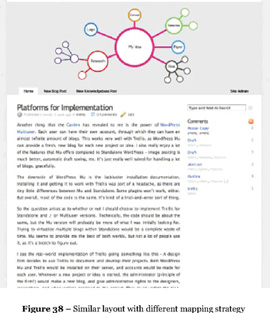
Home > Archive > Recipes & articles > Trellis: Blogging for ideas
![]()
![]()
![]()
![]()
![]()
While the human mind is amazingly robust and adaptable, our ability to generate new ideas is considered the most complex of all of our intellectual functions. Most likely, ideation developed in our ancient ancestors to solve various problems essential to survival, and continues to serve humankind by allowing us to find solutions both small and large – from selecting the perfect birthday gift for our spouses to reversing the effects of global warming.
When dealing with problematic situations, we typically use two approaches, alternatively or in conjunction with one another: algorithmic and non-algorithmic.
An algorithmic approach employs purposeful step-by-step procedures that are strictly follow in order to yield the desired result. When using algorithms, ideas materialize in accordance with the logical sequences of events occurring at the stages of procedural progression. An algorithmic approach is an analytical tool, essentially relying on pure logic.
A non-algorithmic approach also leads to ideas that can be used as solutions, but utilizes non-linear methods, including intuition. This technique involves immediately analyzing a problem and proposing a number of solutions upfront. These fixes are then tentatively applied before choosing the one that will work best. When working non-algorithmically, we generate many ideas at once and then sift them out based on their utility.
Historically, non-algorithmic approaches have fueled ideation in fields such as the arts and social sciences, while algorithmic approaches have led to discoveries in the natural sciences and engineering.
![]()
The ideas that spurred the creation and evolution of information technology - and the technology itself - were developed by using algorithms. In turn, the advent of computers and their intersection in the World Wide Web has had significant impact on our creativity and concept development.
Computers facilitate and enhance our abilities to model and visualize. When we use computers, we reside in a virtual space – cyberspace - that enables us to perform multidimensional modeling and random visualization. By utilizing the capabilities of this medium, we can manipulate various notions, identify their relationships, and even recognize novel relationships we didn’t know existed.
All of these opportunities directly translate into increased creativity. While humans have historically relied on a single mechanism – such as the written word or the voice – to explain and share their ideas, contemporary technology allows us to easily depict our ideas in a variety of forms. It ceases to matter whether a notion should be expressed in letters or visualized in myriad shapes or colors. What matters is the idea itself.
Sharing and collaboration have always been a vital part of the ideation process. The Internet enables us to gain instant and rich communication with people at random points all over the world. Thus, we have endless opportunities to share and collaborate, which in turn tremendously speeds up the ideation process.
![]()
My research into the ways in which computers’ interfaces can promote ideation led to my Master’s Degree thesis and eventually to Trellis, a centralized environment for storing information and developing ideas.
Trellis seeks to facilitate ideation by storing information in a way that’s conducive to developing ideas, and then visualizing the information stored within it. Although Trellis proposes a novel method for handling knowledge, it is by no means a new idea. Indeed, it was created on the back of WordPress, arguably the most popular blogging platform, and then customized for a Flash-based tool for radial mapping called SpicyNodes.
SpicyNodes is an innovative device for visualizing hierarchical information. This article includes a dedicated section focusing on its operation and features. Additional detailed information for users is available in SpicyNodes’ Reference Cookbook, while SpicyNodes’ Developer’s Cookbook is a guide to implementation and customization.
While Trellis relies upon its foundations of blogging and radial mapping to optimize the process of researching knowledge and to smooth out the process of developing ideas, it is still a work in progress. Because it was initially meant to be only an academic exercise, Trellis is not a publicly available service in its current form. My intent in writing this article is to share the ideas conceived in Trellis’ development process.



